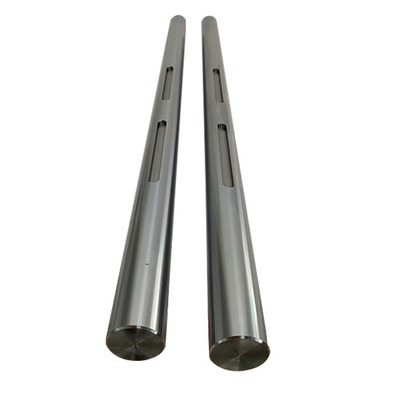Nanocylinder vibration helps quantify 3D printed polymer curing
Researchers from the National Institute of Standards and Technology (NIST) have taken a step towards making more precise and uniform 3D printed parts (such as personalized prosthetics and dental materials), demonstrating a way to measure the rate of microscopic areas of liquid raw materials The method will harden into strong plastic when exposed to light.
NIST's customized atomic force microscope (AFM) has a nano-scale cylindrical tip, revealing the complex process of resin curing, because they react under light to form polymers, and it is necessary to control how much light energy enters the polymer forming and 3D printing processes. The amount of diffusion or diffusion.

The NIST experiment, described in a new paper, shows that the overall exposure conditions (rather than the total light energy commonly assumed) control the degree of polymer diffusion. For example, increasing the light intensity for a constant or short duration will reduce the conversion rate of resin to polymer and may deform the shape of the printed part. These measurements require only a few microliters of resin, thus providing a way to reduce the cost of manufacturing and testing new resins.
Project leader Jason Killgore (Jason Killgore) said: "This research really unearths the unique process and material science insights provided by our new metrology technology."
This work is based on the related AFM method (Sample Coupled Resonance Photodynamics (SCRPR)) previously developed by the NIST team, which can measure the properties and methods of materials in real time at the smallest scale during the curing process. These measurements are made using a conventional cone-shaped AFM probe, which has inclined sides and therefore cannot reliably measure the flow or thickness of local liquids, which is technically called viscosity.
Now, NIST researchers have quantified viscosity, conversion, and diffusion by using a cylindrical AFM probe, which has straight sides and consistent liquid flow. As the probe disturbs the resin, its vibration will be reduced by a certain amount, depending on the cylinder length and fluid viscosity. The increase in the viscosity of the liquid resin is related to the conversion rate, so that the evolution of the polymer in space and time can be measured.
Researchers use computational fluid dynamics to simulate changes in the force and velocity of nanocylinders that slow or dampen oscillations to determine the amount of resin affected by the movement. By correlating SCRPR damping with resin viscosity and conversion rate, the researchers plotted the spatial relationship between conversion rate and time under different exposure conditions.
The AFM is equipped with a light modulator that directs the patterned light from the LED to the resin sample. The measurement results of the conversion rate of the fast-curing resin showed that within a few seconds after exposure, the polymer accumulated tens of microns from the light source, indicating the degree and speed of diffusion. The size of the light pattern is very important. At a given light intensity and duration, wider functions result in higher conversion rates.
SCRPR has aroused the interest of the industry. Killgore said that so far, a company has visited NIST and has used the instrument.
Link to this article: Nanocylinder vibration helps quantify 3D printed polymer curing
Reprint Statement: If there are no special instructions, all articles on this site are original. Please indicate the source for reprinting:https://www.cncmachiningptj.com/,thanks!
 PTJ® provides a full range of Custom Precision cnc machining china services.ISO 9001:2015 &AS-9100 certified. Large scale machining Manufacturer of medical bags, providing 3D design, prototype and global delivery services. Also offering hard cases, semi-hard EVA, soft-sewn cases, pouches and more for OEMs. All cases are made custom according to specifications with infinite combinations of materials, molds, pockets, loops, zippers, handles, logos and accessories. Shockproof, water-resistant and eco-friendly options. Medical parts, emergency response, Electronic parts, corporate, education, military, security, sports, outdoors and construction industries. Services include case concept consultation, 3D design, prototyping,rototyping,CNC Drilling Services and manufacturing.Tell us a little about your project’s budget and expected delivery time. We will strategize with you to provide the most cost-effective services to help you reach your target,You are welcome to contact us directly ( sales@pintejin.com ) .
PTJ® provides a full range of Custom Precision cnc machining china services.ISO 9001:2015 &AS-9100 certified. Large scale machining Manufacturer of medical bags, providing 3D design, prototype and global delivery services. Also offering hard cases, semi-hard EVA, soft-sewn cases, pouches and more for OEMs. All cases are made custom according to specifications with infinite combinations of materials, molds, pockets, loops, zippers, handles, logos and accessories. Shockproof, water-resistant and eco-friendly options. Medical parts, emergency response, Electronic parts, corporate, education, military, security, sports, outdoors and construction industries. Services include case concept consultation, 3D design, prototyping,rototyping,CNC Drilling Services and manufacturing.Tell us a little about your project’s budget and expected delivery time. We will strategize with you to provide the most cost-effective services to help you reach your target,You are welcome to contact us directly ( sales@pintejin.com ) .

- 5 Axis Machining
- Cnc Milling
- Cnc Turning
- Machining Industries
- Machining Process
- Surface Treatment
- Metal Machining
- Plastic Machining
- Powder Metallurgy Mold
- Die Casting
- Parts Gallery
- Auto Metal Parts
- Machinery Parts
- LED Heatsink
- Building Parts
- Mobile Parts
- Medical Parts
- Electronic Parts
- Tailored Machining
- Bicycle Parts
- Aluminum Machining
- Titanium Machining
- Stainless Steel Machining
- Copper Machining
- Brass Machining
- Super Alloy Machining
- Peek Machining
- UHMW Machining
- Unilate Machining
- PA6 Machining
- PPS Machining
- Teflon Machining
- Inconel Machining
- Tool Steel Machining
- More Material





